4. BioChromes¶
Research & Ideation¶
I had gone into this week with a huge blank. Nothing about this week was a familiar territory for me. Tuesday's very informative lecture by Cecilia was equal parts overwhelming for me too. Little by little, with every tutorial and every experiment I started to understand the process.
Plant and animal dyed fibers:
Bacteria dyed silk fabric:

References & Inspiration¶
I am facinated by how Bauhaus weaving workshop worked digilently on weaving and moved a "woman's craft" towards a design field. The most important part of this shift was through teaching and finding ways to document their processes. The following are some of the material libraries created by instructors who taught these classes or by student's who took these classes.
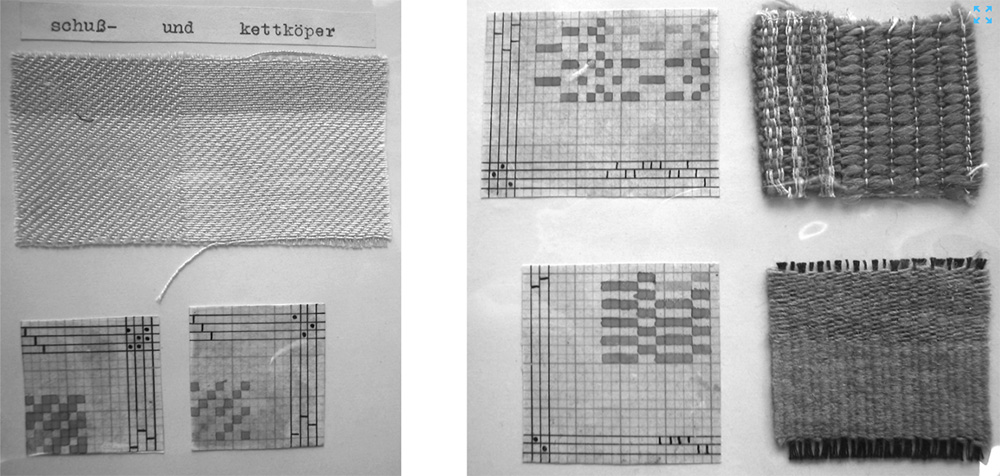
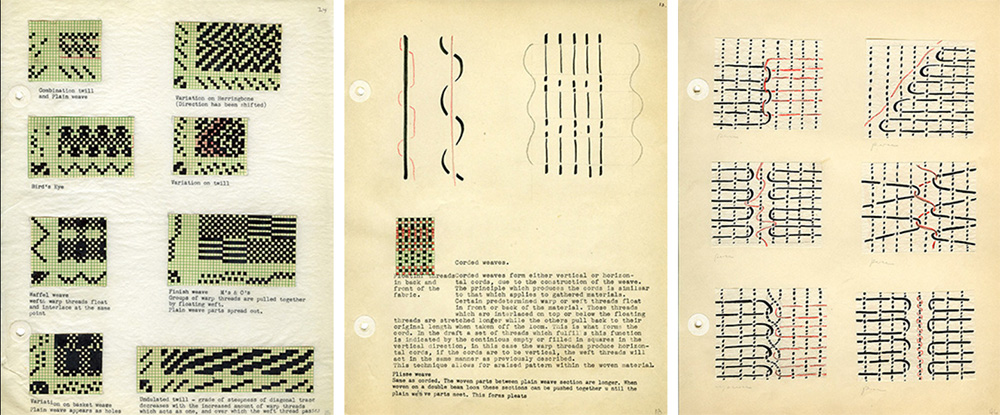
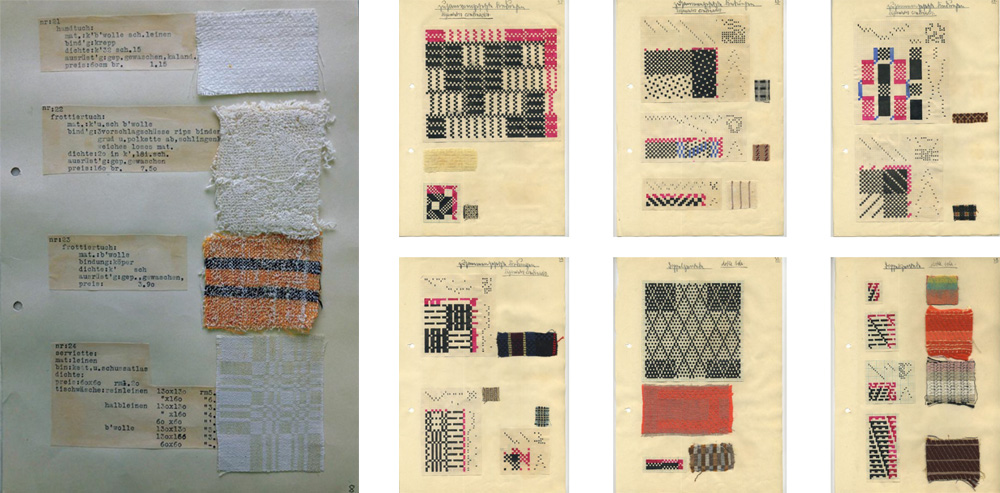
Tools, Ingredients and Textiles¶
Natural Dyes
Ingredients:
- Natural dye stuff
- Sodium carbonate
- Alum
- Tartaric acid
- Iron sulphate
- Citric acid
- Water
Tools:
- Stove
- Pot
- Container
- Sieve
- Teaspoon, tablespoon, ladle, wooden spoon, tongs
- Kitchen scale
- Sensitive pharmacy scale
- Containers of various sizes
Textiles:
- Natural fibers: cotton fabric, Dutch wool, cotton thread, South American (Alpaca) wool
Bacterial Dyes
Ingredients:
- Luria broth
- Nutrient agar
- Peanut butter
- Demineralized water
- Serratia Marcescens (bacteria that gives pink color)
Tools:
- Petri dish
- 60% ethanol
- Pressure cooker
- Incubator
- Campin gas + lighter
- Inoculation loop
- Autoclave bag
- Parafilm tape
- 500ml glass bottle with cap
Textiles: - Natural fibers: silk fabric - Needle (or sewing machine) and thread
Process and workflow¶
Natural Dyes¶
- Weighing fibers
- Scouring
- Tanning (if you want the color to last longer) - we skipped this step in our experiment. However, we used Oak Galls, which are used for tanning, to color our fibers in the dyeing step
- Mordanting
- Dyeing
- Making pigments
Weighing fibers¶
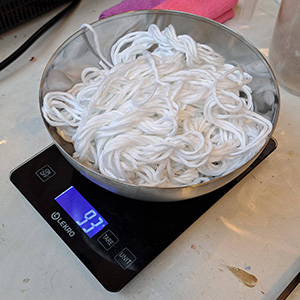
It is really important to weigh your fibers dry before starting the whole process. The recipes rely heavily on the weight of the fibers because you measure the amount of each ingredient depending on the fiber weight. For our collective experiments, the following are the weights of fibers:
- Cotton thread: 3 gr per piece, 32 pieces total.
- Cotton fabric: 30 gr per a piece of fabric measuring 580*680mm, 8 pieces total.
- Dutch wool: 10 gr per pieces, 24 pieces total.
- South American wool (Alpaca wool): 5 gr per pieces, 14 pieces total.
Scouring and Mordanting¶
Scouring is cleaning the fibers from dirt and oil. Our wool fibers were clean to start with, so did not scour them. For the amount of cotton fibers we had, we boiled 6lt of water and put 2 heaps of tablespoon of Sodium Carbonate in a pot and stirred. We put the cotton thread and cotton fabric in the boiling water and simmered for 1 hour.
Mordanting acts like a catalyser for binding the dye pigment to fibers. We used tepid water for mordanting because wool cannot be in boiling hot water. For mordanting wool, you need Potassium Aluminum Sulphate (Alum) (10-20% weight of the fibers) and Tartaric acid (8% of the weight of the fibers). We mordanted for 1 hour. If you are using the leftover mordant water to mordant again, you assume the strength of the mixture is half the strength and calculate dependently. You do not need tartaric acid for cotton fibers.
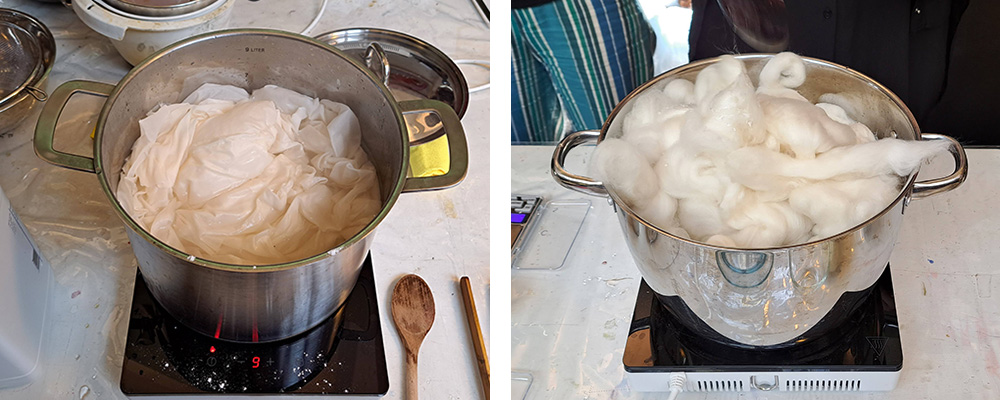
Dye Baths¶
We prepared the dye baths for 100gr of fibers.
Here are the amounts of dyestuff we added to each dye bath pot:
| Dyestuff | Source | Source Part | Modifier | Amount (gr) | Fibers |
|---|---|---|---|---|---|
| Madder | Plant | Root | NA | 100gr |  |
| Madder | Plant | Root | Citric Acid (CA) | 100gr, a pinch CA |  |
| Holyhock | Plant | Flower | NA | 20 gr |  |
| Red onion | Plant | Fruit Skin | NA | 50gr |  |
| Campeche | Plant | Bark | NA |  |
|
| Cochineal | Animal | NA |  |
||
| Cochineal | Animal | Citric Acid |  |
||
| St John's Wort | Plant | Flower & Leaf | NA |  |
|
| Oak Gall | Plant | Gall | NA | 35 gr |  |
| Oak Gall | Plant | Gall | Iron | 1gr? |  |
| Rhubarb | Plant | Root | NA | 30gr |  |
| Rhubarb | Plant | Root | Iron |  |
|
| Weld | Plant | NA | 60gr |  |
|
| Horse Chestnut | Plant | Fruit skin | NA |  |
|
| Sweet Pea | Plant | Flower | NA | 20 gr |  |
Some of the raw materials in petri dishes:
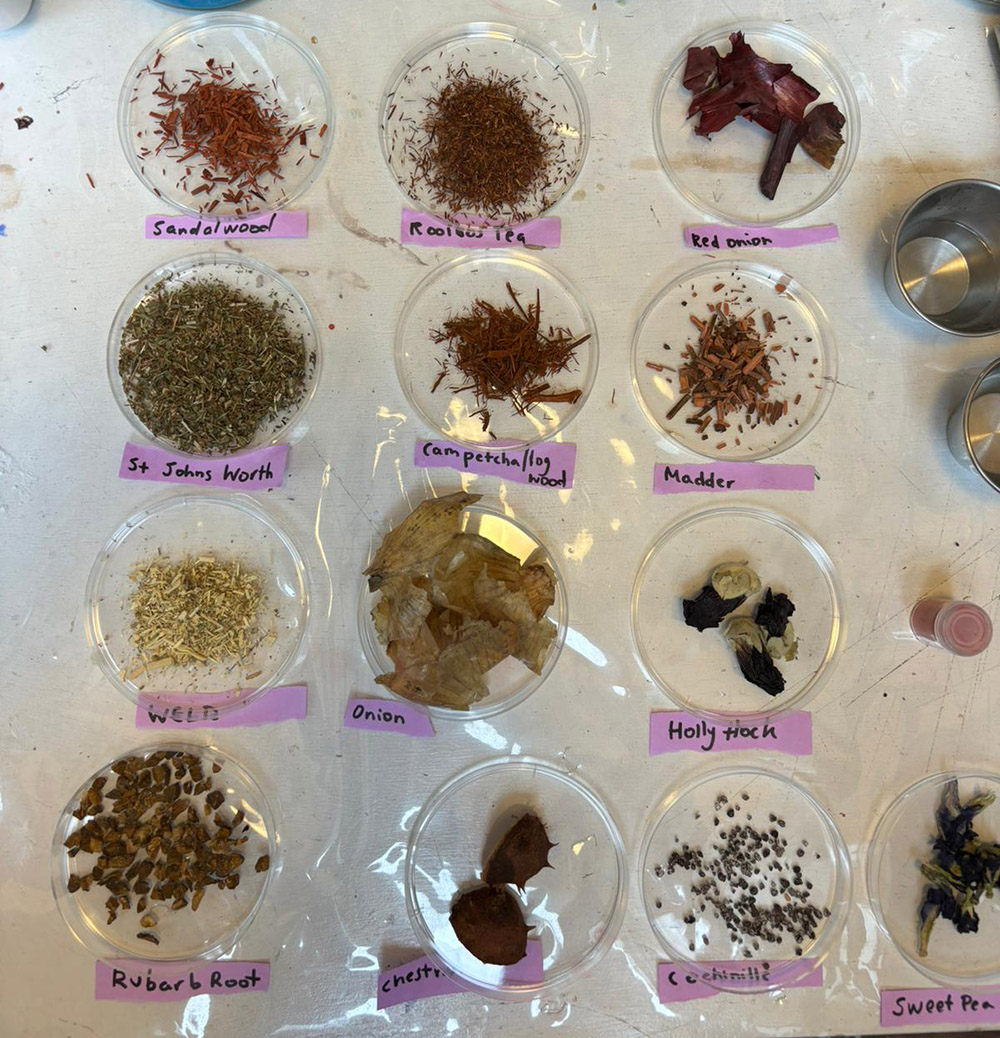

Making Pigments (recycling dyes)¶
We used cochineal rinse bath, red onion dye bath and madder dye baths to learn about making pigments.
For 1lt of bath you approximately need 15gr of Alum and 7.5 gr of Sodium Carbonate (actually Sodium Carbonate depends on the pH level of the bath).
- Heat the source bath (madder should not be above 60 degree celcius).
- Take 1lt of liquid from the source bath, add and stir Alum really well.
- Start adding and stirring Sodium Carbonate slowly, it will bubble up so use a container that is twice the volume of your liquid. Stop adding more carbonate when you see that the liquid does not bubble up when you add more.
- Stir occasionally and then let it precipitate. You will see that the particles will build up at the bottom and a clear water will emerge at the top.
- Try to remove as much as the clear water (this part does not have any substantial pigment in it).
- Line a funnel with a coffee filter, it is better if you use one without seams, and put the funnel above a container to catch the liquid coming out. Filter your precipitated mixture through the funnel.
- Let it dry completely.
- Grind and store them dry.

I haven't had time to experiment coloring paper with pigments but it is definetely on my to do list.
Bacterial Dyes¶

We dyed our silk fabrics with Serratia Marcescens bacteria. This bacteria likes damp environment and usually can be found in bathrooms. Of course, we work with biosafety level 1 bacteria so it is low-risk that actually does not require special equipment or containment to work with. (image link)
Warning
Some important Biosafety Rules to follow in the BioLab:
- Tie your hair.
- No jewelery.
- No food or drinks in the lab.
- Do not bring phones or notebooks to the lab. There is a lab phone and notebooks in the lab which you can use for documentation. They are not to be taken outside.
- Wash your hands before going in the lab and coming out of the lab.
- Wear a lab coat.
- All windows and doors should be shut during an experiment.
- Sterilize your tools in the pressure cooker.
Preparing the fabric¶
I Folded by fabric to four and sewed it diagonally and scrunched up some of the stitch lines.

Preparing the fabric for bacteria growth¶
We used paper towels and ethanol to sterilize the table.
Methods of sterilization:
- Heat
- UV light
- Alcohol
- Acidity
Firstly, we put fabrics in the petri dishes. Then, we prepared the food for the bacteria according to the preparation manual on the bottles. We prepared to two bottles, one with Luria Broth and the other with Nutrient Agar. Nutrient Agar has a very thick consistency so it needs to be heated a little if stored in the fridge.
| Food | Nutrient amount (gr) | Demineralized Water (ml) | Peanut butter (gr) |
|---|---|---|---|
| Nutrient Agar | 9,3 gr | 300 ml | 0,5 gr |
| Luria Broth | 7,5 gr | 300 ml | 0,6 gr |
We put the petri dishes in autoclave bags and seal them really well so the contents stay dry. Then, we put the bags and the food bottles (they should be slightly open so that they do not explode in the pressure cooker) in the pressure cooker.
Sterilization in the pressure cooker takes place at 121 degree celcius for 20 mins.
Camping gas fire helps to create a sterilized bubble for bacteria, make sure you create a circle (circa 50cm diameter) with ethanol and make the flame of the fire as blue as possible. After the sterilization in the pressure cooker, bring the food and petri dishes under the bubble of the fire. Pour the food on top of the fabrics in the petri dishes. (We put LB in three of the petri dishes and NA in two of the petri dishes). Scoop some bacteria with inoculation loop and smear it on a few places on the fabric. Seal the petri dishes with parafilm tape. Put the pteri dishes in the incubator. Incubator helps to create a steady environment for the bacteria at 18-20 degree celcius.

The Progress of the bacteria growth¶
I checked up on my bacterias every day (at least on the days that I was at the lab). After 24 hours, the dish looked very sad, there was only slight pink color under the tape, which conceals it. After 48 hours, the dish showed a big leap from the previous day. All doubts of contamination were put to rest. After 120 hours they hav flourished.

When we compared the progress in the other dishes as well, we observed that NA fed bacteria were not spreading as rapidly as LB fed ones. On the other hand, they exhibited an interesting bubble like growth pattern and also a darker color of pink.
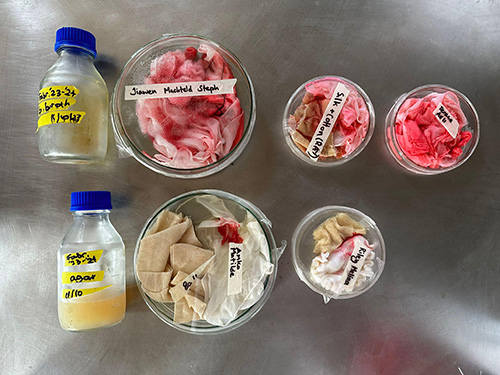
We sterilized the LB fed petri dishes in the pressure cooker to kill the bacterias.
The resulting pattern on the silk fabric shows that pattern is more visible on the scrunched up side. The below image is aligned with the pattern creation images. Therefore the scrunched up side is on the left.

Avocado experiment (personal experiment)¶
Dye Baths¶
I wanted to see the effect of pH changes on the dye colors. I prepared avocado dye baths with changing pH values.
Measurements:
- 144gr avocado (5,5 skins and 2 pits -pits are chopped to 8 pieces each-)
- 5 lt water
- 55gr of fibers (slightly wet) 8gr per each bath
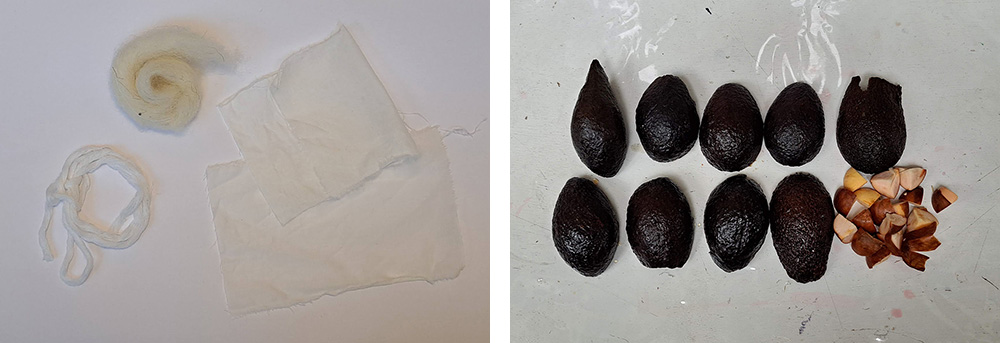
Heat the water up to 80 degrees. Add the avocado in. Simmer for 1 hour.
Prepare 5 baths by changing the pH value.

Put your fibers in. When checked on my fibers after 1 hour, I was not satisfied with the color cought on them. I let the fibers sit in dye baths over the weekend. In total, they stayed in the baths for 72 hours. Let them dry in the shade.

The overall table with ingredient measurements and bath colors and fiber outcomes are as followed:
| Experiment | Modifier (gr) | pH | Dye Bath Color | Fibers |
|---|---|---|---|---|
| Experiment 1 | NA | 8 | 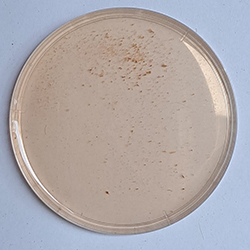 |
 |
| Experiment 2 | Citric acid (2gr) | 4 | 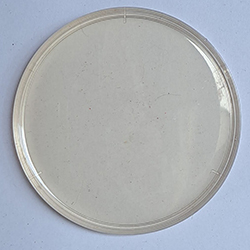 |
 |
| Experiment 3 | Iron (2gr) | 7 | 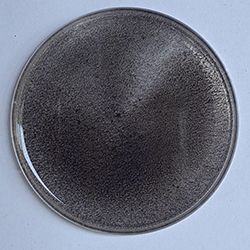 |
 |
| Experiment 4 | Sodium Carbonate (2gr) | 11 | 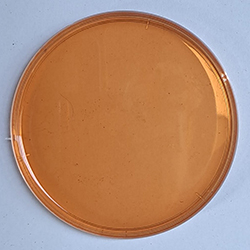 |
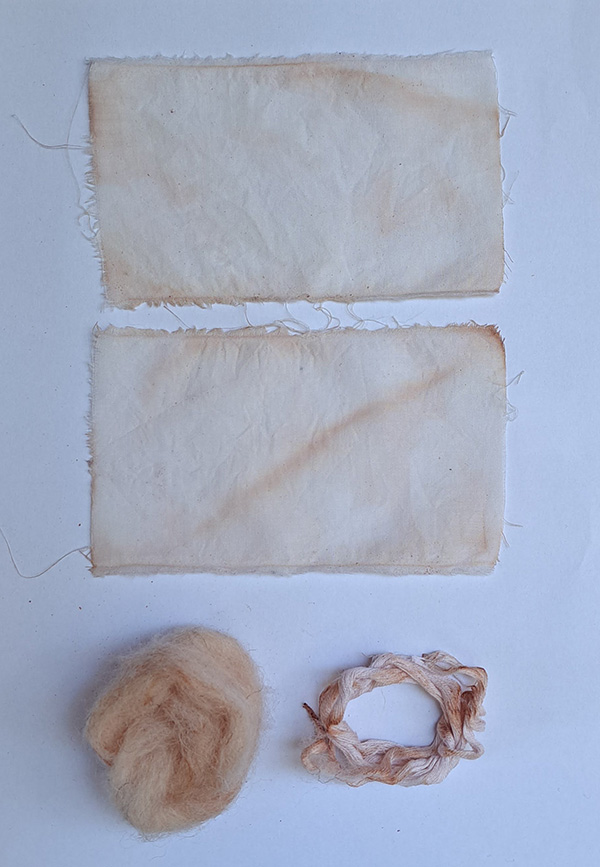 |
| Experiment 5 | Sodium Carbonate (4gr) | 13 | 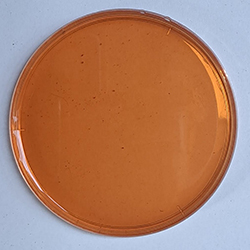 |
 |
Resulting Fibers from the Dye Baths¶
Notes from the Classroom¶
notes from the classroom
- Biochromes - definition
- Cueva de las Manos, Santa Cruz, Argentina - humans saying I am here
- Tutankhamun's Tomb - painter's palette
- Mayan Blue - sublimation , heating the color into a gaseous state and transfering it into clay
- Oldest flax (linen) plant dyed fibers - Dzudzuana Cave in Georgia
- Modern Understanding of Color - Isaac Newtoon, Optics Treatise
- Color Theories - Goethe, Theory of Colors
- Mapping colors as a challange
- Color Spaces - Philip Otto Runge
- William Perking - first synthetic color
- Lizerin - important!
- Poison - green color included arsenic, poisoning aristocrats
- Conventional dyeing processes consume large amounts of water
- We do not what our garments are dyed with
- Miriam Rice - mushroom dyes 1970s
- 1980s-today - bacterial pigments
- Color is life; for a world without color appears to us as dead. Colors are primordial ideas, the children of the light." Itten, color theory
Biochromes - values driven living colors approach (SUSTAINABLE)
- Locally positive
- from waste streams
- lab scale opportunity
- locally growing
- locally empowering
- heritage knowledge
- biodiversity - endangered species
- Biobased (and compostable)
- .... continue from photo
Bio-based fibers -> Mordant/adjective ... -> Biochromes
Biochromes sources - animal (insects, mollusks), botanical (seeds, fruits, leaves, flowers, bark, wood, ), mineral, bacterial, fungal
Biochromes palettes - animal, botanical (biochromes.org), mineral (Ane Baztarika - Amsterdam TextileLab 2016), bacterial, fungal (mushroomcoloratlas.org)
Biochrome Coloring Forms
- Ink - dense liquid, soluble/dispersed, into the material/onto the material
- Dye - liquid bath, soluble is water, into the material
- Pigments - ....
PROCESS
Weight of Fibers (WoF) 1. Weigh the textiles
Tanning (only with vegetable)
Mordanting 10. Combine water with mordant (alum or iron) 11. Heat up
Dye bath 13. Combine dye stuff & vehicle 14. Simmer - stir & strain 15. Remove, strain and rinse 16. Preserve/thicken/modify
Animal fibers (take the color really well, bright color) - wool, silk, angora, mohair, Vegetable fibers (slightly lighter in color) - cotton, linen,... Made fibers - tencel lyocell,
Tanning, mordants & modifiers - Fibers preparation -
Scouring agents & tannins - Oak galls - Sodium carbonate - Tara Pods - Myrobalan - Sumac, cutch & pomegranate
Mordants & binders - Alum - makes very bright, yellow cold - Iron - makes darker, sadder, wear gloves - for darker colors - Copper - try to do very little, not healthy, do it outside and wear gloves, blue, green - Symplocos (all kinds of fibers, natural bioaacumulator of alum) & lycopodium (natural bioaccumulatant of alum, with all colors, process is quite long, endangered species) - Soy - binder, make a milk and use it as a binder
Modifiers - Acidic - Alkaline - ...
DOCUMENTING DYES
Dye Stuff: - Domain - Name - Matter type - Compound - Origin - Environmental - Date
Recipe: ...
Bacteria: Pink: We only work with biosafety level 1 Purple: very mild bioshades.bio (open-source) Victoria Geaney PILI
https://aosc.online/index.html https://tcbl.eu/
Anthotype (dying with fugitive pigments): https://en.wikipedia.org/wiki/Anthotype
